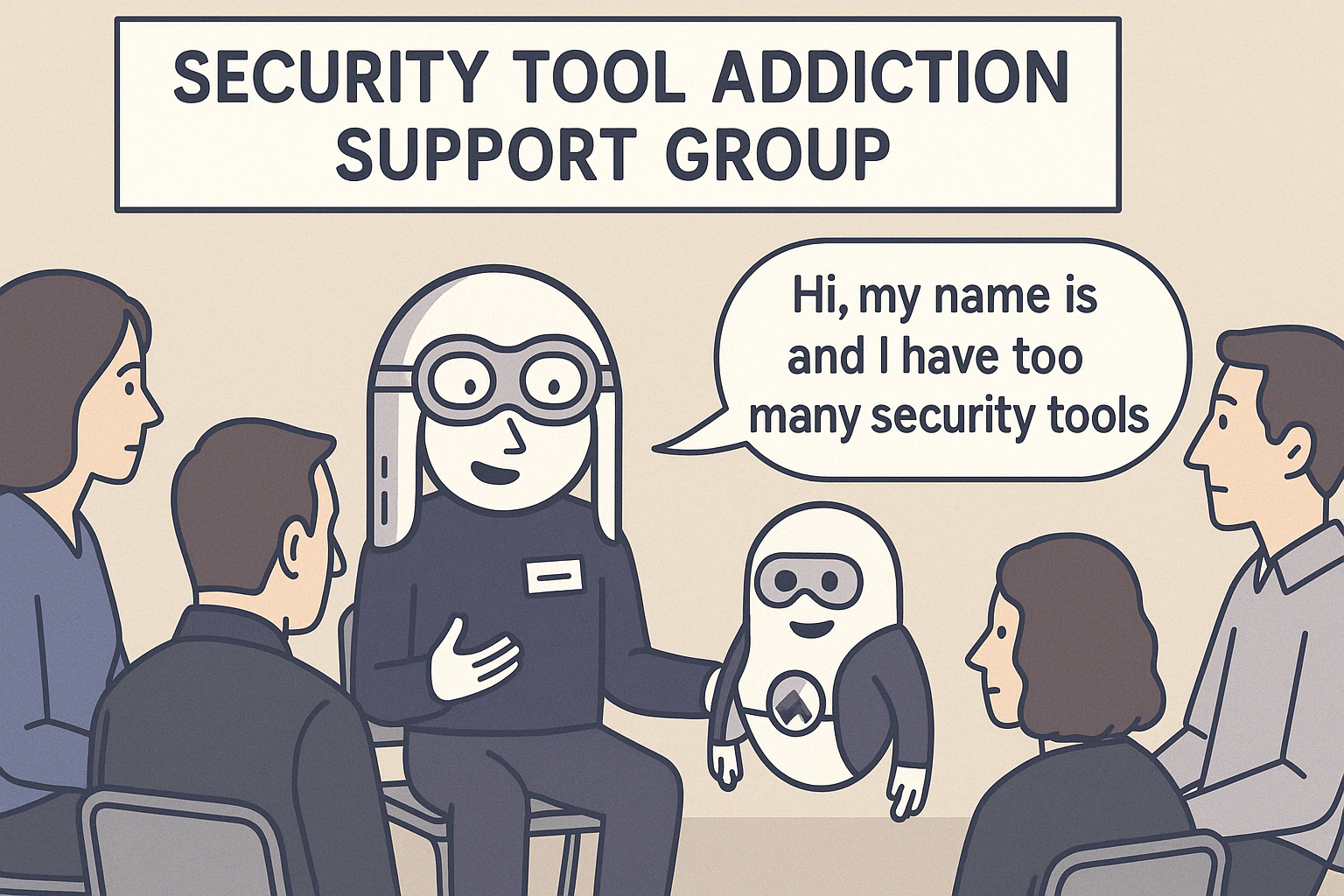The Security Tool Symphony: Orchestrating Chaos with MCP and Graph Databases 🎭
Ever had that moment during a security incident when your colleague asks where a specific piece of information is, and you respond with “It’s in… um… one of these 47 open tabs”? If your security operations center resembles my kitchen junk drawer—technically organized but practically a disaster—then pull up a chair. We need to talk about your tool hoarding problem.
My Security Tool Addiction Support Group
Hi, my name is [Your Name], and I have too many security tools. [This is where you all say “Hi” back]
Last month, I found myself explaining to our CFO why we need yet another security platform while simultaneously trying to remember my login credentials for the previous three we purchased. It was about as graceful as my attempt at paddleboarding last summer—lots of flailing, unexpected splashing, and eventually just accepting that I was going down with dignity.
The problem isn’t that these tools aren’t useful—they’re brilliant at their specific jobs. It’s that they’re like those dinner party guests who refuse to talk to each other despite having plenty in common. Your SIEM is collecting dust in one corner, your EDR is drinking alone by the snack table, and your vulnerability scanner is telling the same story to anyone who’ll listen.
Enter MCP: The Digital Party Host We Deserve
Model Control Protocol (MCP) has emerged as the unexpected hero in this fragmented landscape—think of it as that charismatic friend who somehow knows everyone and makes introductions that actually stick.
Originally developed by Anthropic but now open for all, MCP allows models to interact with your existing security tools and systems without requiring you to rip everything out and start again (a relief to my change-averse infrastructure team, who still regard new software with the suspicion normally reserved for mysterious food items found at the back of the refrigerator).
What makes MCP special isn’t just that it can talk to your tools—it’s that it provides a common format for these interactions. It’s like establishing English as the official language at an international conference instead of having everyone shout in their native tongues while waving translation dictionaries about.
The Graph Database: Where Your Security Data Finally Makes Sense
Now, imagine taking all this beautifully integrated data and organizing it in a way that actually reflects how security really works—as an interconnected web of relationships.
Traditional databases are like filing cabinets—rigid, compartmentalized, and utterly useless when you need to quickly understand how things relate to each other. (“Hold on while I check these 12 separate folders to see if these alerts are connected!” said no efficient security analyst ever.)
Graph databases, by contrast, are designed specifically for relationship mapping. They store data in nodes (the security concepts) and edges (the relationships between them). So your database might have nodes for:
- Security requirements
- Controls
- Risks
- Vulnerabilities
- Assets
- Incidents
- Tasks
- Audit events
When a new vulnerability appears, it doesn’t just sit in isolation—it automatically connects to affected assets, relevant security controls, compliance requirements, and potential risks. It’s like the difference between having a thousand puzzle pieces scattered across the table versus having a completed puzzle where you can actually see the picture.
What This Looks Like When It’s Not Just Marketing Fluff
Picture this scenario: It’s 3 AM (because security incidents respect work-life balance about as much as my neighbor’s dog respects quiet hours), and an alert comes in.
Without MCP and a graph database: You log into your SIEM, export the alert details, log into your asset management tool to identify the system, check your vulnerability database to see if there are related vulnerabilities, manually correlate timestamps with your EDR, check compliance implications in yet another system, and then try to document all this while your phone keeps buzzing with increasingly frantic Slack messages.
With MCP and a graph database: You ask a simple question like “What’s the context of this alert?” and get back:
- The affected asset and its criticality
- Related vulnerabilities and patches
- Recent changes to the system
- Similar past incidents and their resolutions
- Compliance implications
- Suggested remediation steps

All without logging into multiple systems or building custom integrations that break every time a vendor updates their API (an experience that ranks somewhere between stepping on Lego and realizing you’re out of coffee on Monday morning).
Building Your Security Graph One Node at a Time
The beauty of this approach is that you don’t need to implement everything at once. You can start small:
- Define your key security concepts as nodes
- Set up MCP servers for your most critical tools
- Begin mapping relationships between entities
- Gradually expand to include more data sources and relationships
It’s like gardening, but with fewer dirt stains and more cybersecurity insights. You plant the seeds, tend to them regularly, and watch as your security graph grows increasingly comprehensive and valuable.
The “What Could Possibly Go Wrong?” Section
Of course, as security professionals, we’re contractually obligated to consider what could go wrong. Giving an AI system access to multiple security tools is a bit like letting your teenager use your credit card online—convenient but potentially catastrophic without proper controls.
Consider implementing:
- Strong authentication for MCP servers
- Detailed audit logging (for when someone inevitably asks “who told the AI to do THAT?”)
- Approval workflows for sensitive actions
- Regular validation of the data and relationships
After all, the only thing worse than disconnected security tools is perfectly integrated tools all making the same mistake simultaneously with exceptional efficiency.
The Future: Connected, Contextual, and Slightly Less Chaotic
The future of security operations isn’t about adding yet another blinking dashboard to your collection. It’s about connection and context—having a system that understands the relationships between different security concepts and can draw meaningful conclusions.
MCP and graph databases together transform our security data from a chaotic jumble into an interconnected web of meaningful relationships. They make our existing tools smarter without replacing them, which might be the first time in IT history that a new approach didn’t require throwing away everything you’ve already invested in (a miracle roughly equivalent to finding extra fries at the bottom of your takeaway bag).
So if you’re tired of security operations that involve more tab-switching than actual analysis, perhaps it’s time to explore what MCP and graph databases can do for your organization. Because let’s be honest—the only thing that should be fragmented in your security program is the remains of the threats you’ve successfully neutralized.
What’s your experience with security tool integration? Are you exploring MCP or graph databases for security operations? Share your thoughts in the comments!
P.S. My next article will feature “Security Tool Bingo”—a game where you mark off squares every time a vendor claims their platform is “the only solution you’ll ever need.” Spoiler alert: everyone wins within the first five minutes of any security conference.
A Slightly Important Note (That My Marketing Team Insisted I Include)
I’d love to hear your thoughts, experiences, and tales of security tool woe in the comments! Whether you’ve successfully tamed the multi-tool beast or are currently drowning in a sea of dashboards and credentials, your stories help us all feel less alone in this chaotic security landscape.
Full disclosure: I’m part of the team working on WINGMAN, where we’re attempting to solve exactly this problem. Not that I’m biased or anything, but it’s a bit like being on the team that invented ice cream—you know you’re onto something good, even if you occasionally get brain freeze during testing. We’re using these exact concepts of MCP integration with graph databases to create security context that actually makes sense.
If you’ve made it this far into my rambling, you deserve a medal—or at the very least, a demo. Feel free to reach out if you’re curious about how we’re approaching this challenge. I promise our demos involve 90% fewer technical difficulties than my home DIY projects.
